After-Hours Tour of the Fraunces Tavern Museum: "Path to Liberty"
Explore a new exhibit inside the oldest building in Manhattan, a witness to history throughout the Revolutionary War Era!


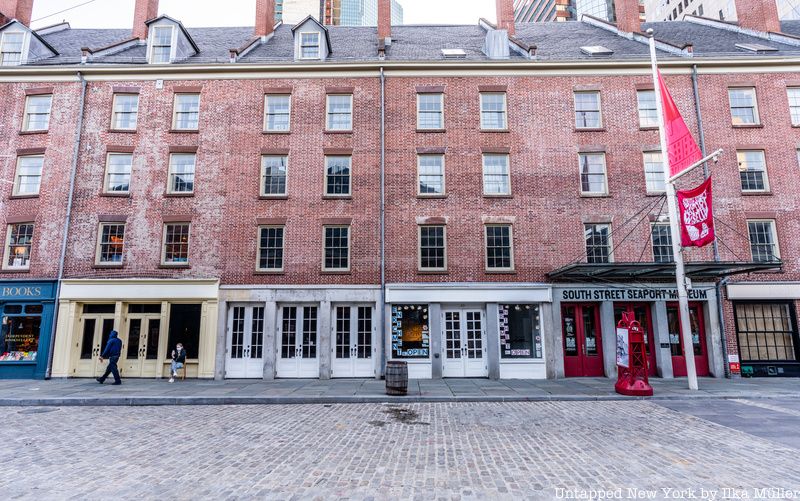
Though you could stand on Manhattan today and forget you are on an island, for centuries, New York City’s success depended on its maritime industries. Since the days of the native Lenape, the surrounding waterways have played an integral role in New York life. One of the places where New York’s nautical history is most evident is the South Street Seaport. Started as a small collection of 18th-century wharves, the South Street Seaport eventually grew to be part of one of the most important commercial ports in the world. In the seaport district today, you will find historic ships, stunning views, and landmark buildings that date as far back as the late 1700s. Below, take a dive into the rich history of the seaport and uncover its secrets!
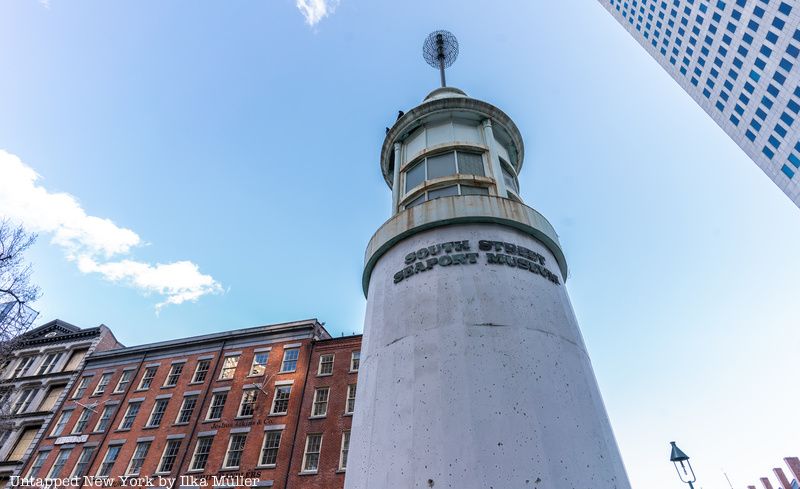
Standing outside the Seaport Museum is a land-locked lighthouse and time-ball. This maritime signaling structure doesn’t warn ships of danger but serves as a memorial to the victims of the Titanic sinking in 1912. The luxurious and ill-fated cruise ship was en-route to New York City from England when it tragically sank in the Atlantic Ocean. The 60-foot Titanic Memorial Lighthouse and Time Ball was dedicated on April 15, 1913, one year after the sinking of the Titanic. It was originally mounted on top of the Seamen’s Church Institute at 25 Water Street.
Every day at noon, from its installation in 1913 until 1967, the Titanic time ball received a telegraphic signal from the Naval Observatory in Washington D.C and dropped halfway down the pole to indicate the time. A time ball is an obsolete time signaling device which enabled navigators aboard ships offshore to verify the setting of their marine chronometers.
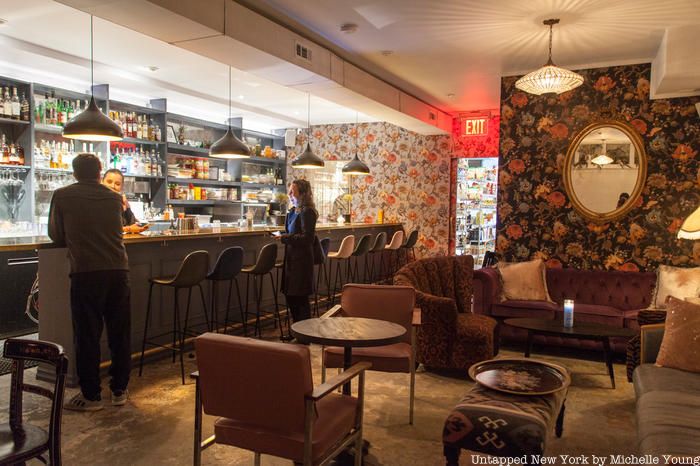
Located on Front Street between Peck Slip and the Brooklyn Bridge overpass right near the South Street Seaport, The Little Shop is a hidden speakeasy with a front that isn’t just for show. Before you get to the cozy couches and delicious cocktails at the secret bar in the back, you first arrive at a fully-stocked bodega. The owners of The Little Shop, Philippe Boujnah, and Anna Bazhenova, saw a need for both a place where local residents could pop in to pick up necessities and a quiet, comfortable place where they could enjoy a drink.
The speakeasy in the back is meant to feel like home. All of the decor and vintage drink glasses were acquired at the Brimfield Flea Market in Massachusetts or from local residents! The food and drinks served at the bar are unpretentious and represent the varied cultures of New York City. The owners hope the shop will grow and evolve with the surrounding neighborhood.
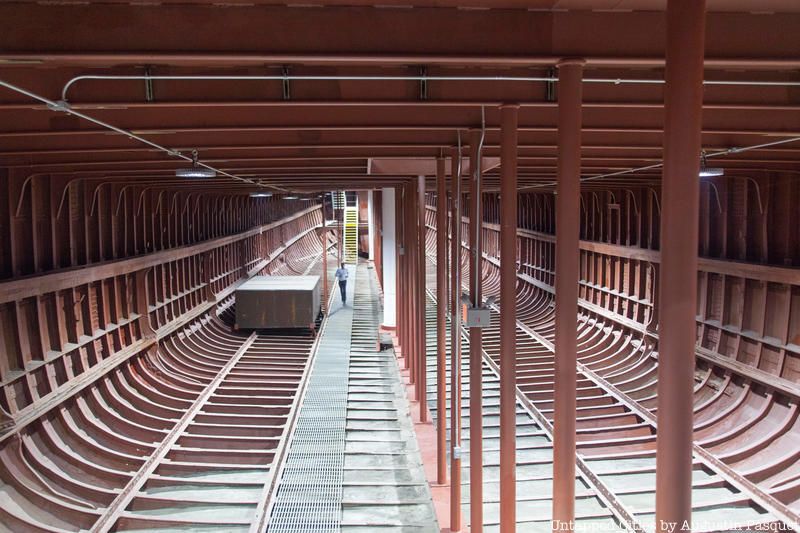
At the South Street Seaport, you can see New York City’s rich maritime history come to life in the many remnants of the old port of New York. The Wavertree, a cargo ship built in 1885, is one such remnant you can interact with. The Wavertree first arrived in New York City in 1895 on its way to Calcultta with a load of jute on board.
In 1968, the South Street Seaport Museum acquired the Wavertree and after a 16-month, $13 million restoration at Caddell’s Dry Dock and Repair Co. on Staten Island, it was finally opened to the public in 2016. The Wavertree is now permanently moored at Pier 16 at the South Street Seaport. Visitors who purchase admission to the South Street Seaport Museum are invited to tour the Wavertree’s main deck, fo’c’sle head, deckhouse, galley, quarter-deck, and captain’s saloon. You can also get inside the “Cathedral,” the immense cavernous space where cargo was held. The South Street Seaport Museum and the Wavertree are both currently closed due to COVID-19.
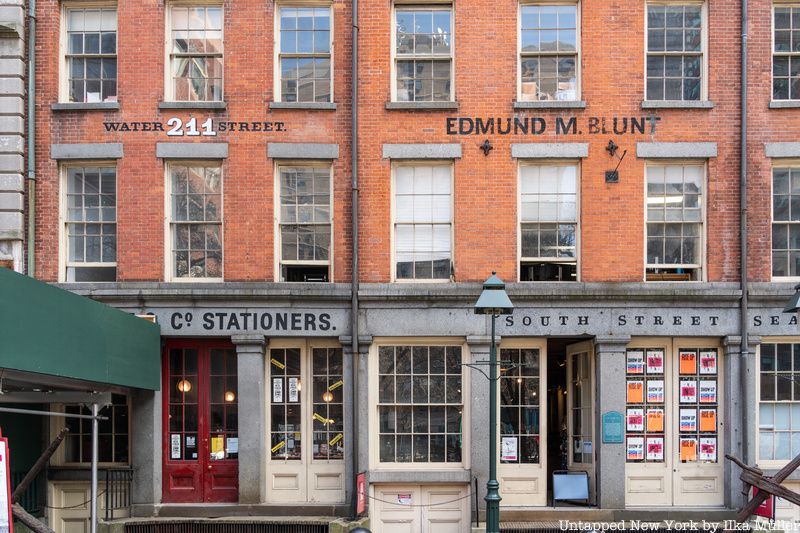
Bowne & Co. is New York’s oldest operating business under the same name! The company was established in 1775 by Robert Bowne. Most of New York City’s 700 printing offices at the turn of the 20th-century were located in Lower Manhattan and in the Seaport District. The booming maritime industries needed printed materials like invoices, and advertisements, so it was convenient to have the printers nearby.
The printing company partnered with the Seaport Museum in 1975 to create a 19th-century-style print shop. The shop at 211 Water Street features a collection of seven historic letterpresses, that are still in use! Resident printers at the shop can help customers create individual designs using custom plates or historic fonts, just like printers have been doing for almost 200 years. The shop also features an array of eclectic gifts and stationery. You can explore more of the historic buildings of the seaport in a new study created by the National Maritime Historical Society which highlights the South Street Seaport Museum and other at-risk historic structures.
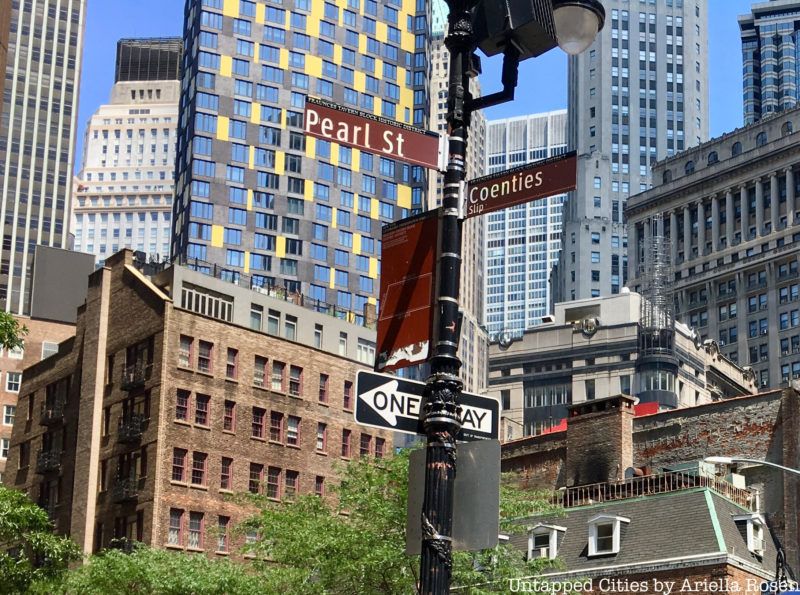
There are many theories as to how Pearl Street got its name. Dubbed Parelstraat by the Dutch, it is one of the roads laid out in the colonial street grid of New Amsterdam. When the Dutch occupied New York City, Pearl Street (the English anglicized the name in 1794) was the East River shoreline of Manhattan.
It is believed that the road got its name from the abundance of oysters in New York City’s waterways. It is likely that there was a large midden, a huge pile of oyster shells, on the street that inspired the name. Before the Europeans arrived and became smitten with oysters, the native Lenape people were already eating them and creating large piles of discarded shells. It is also believed that the Dutch crushed oyster shells and sprinkled them on the street as a form of paving.

Before the 2018 arrival of SHoP Architect’s 300,000 square-foot building at Pier 17, there was the Pier 17 Mall. The red steel and glass building was designed by Benjamin Thompson & Associates. In opened in 1985 as part of a revitalization of the Seaport District and became a tourist attraction in the area.
After decades of ups and downs, the mall closed in 2013, nearly thirty-years after it originally opened. Like the rest of the area, the mall’s business had been severely impacted by Hurricane Sandy. Untapped New York documented its demolition and the mixed responses to its removal. The mall was replaced by multi-use glass-clad building with a mix of dining, retail, and gathering spaces. The most exciting feature of the new Pier 17 building is the roof deck which serves as an entertainment venue and large-scale public space.
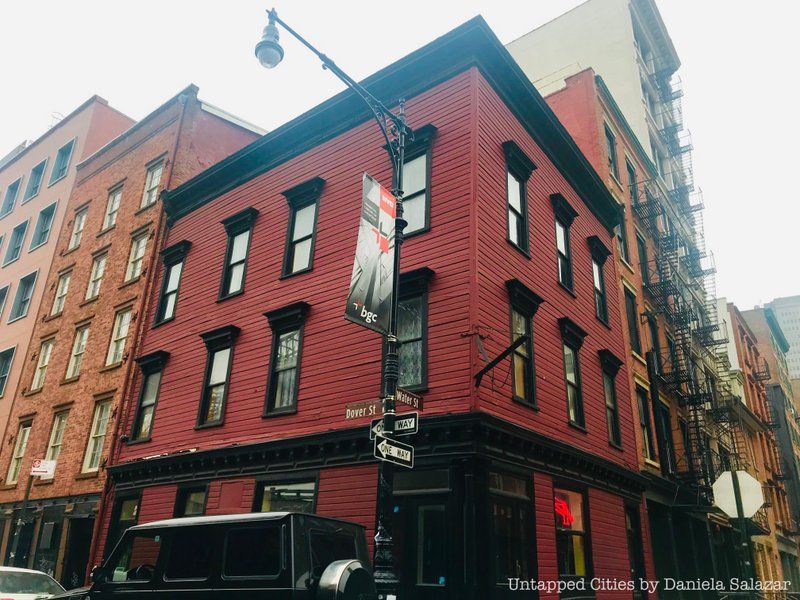
279 Water Street is the address of one of New York City’s oldest bars, The Bridge Cafe. The building reportedly dates back to 1794 (though the Landmarks Preservation Commission dates it to 1801) and is the only wood-framed building within the South Street Seaport Historic District. The Bridge Cafe, which closed for restorations after Hurricane Sandy in 2012 and has yet to reopen, claimed to be the oldest continually operating bar in New York City. As of February 2020, according to the Wall Street Journal, the owner was still hoping to revive it.
In the 19th-century, the bar had a gritty reputation. Located directly under the Brooklyn Bridge and in close proximity to the old Fulton Fish Market, the bar attracted river pirates and gamblers and was the site of multiple murders. One “lady bouncer” known as Gallus Mag allegedly bit off the ears, or occasionally a finger, of uncooperative patrons and pickled them in a large jar she kept behind the bar!
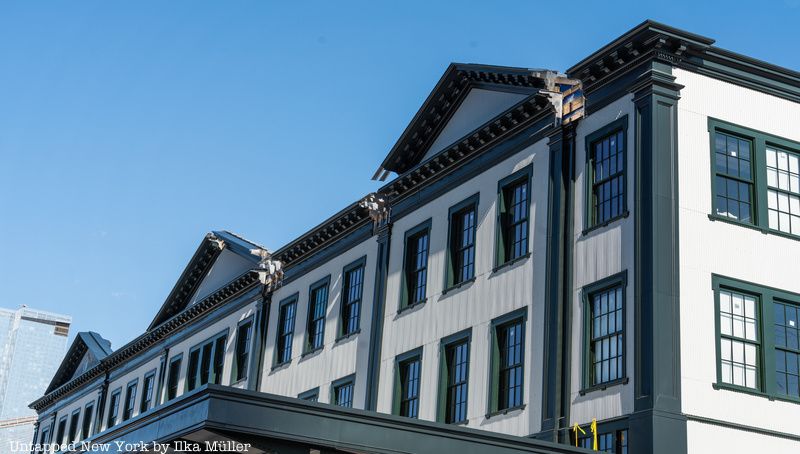
The Fulton Fish Market has had a presence at the seaport since 1822. It was and still is one of the largest wholesale fish markets in the country, though it isn’t located in the South Street Seaport anymore. In 2005, the market relocated to Hunt’s Point in the Bronx. Before the move north, the market was housed inside the 1907 Tin Building and the 1939 New Market Building. Sadly, after a failed campaign to landmark the New Market Building, it was slated for demolition in 2018. The Tin Building, on the other hand, which is a New York City landmark, has been reconstructed.
This is the second resurrection of the Tin Building, as it was rebuilt before, in 1995 after a fire. In 2016, the Landmarks Preservation Commission approved plans to relocate the building, moving it thirty-three feet away from its original spot. Hamilton Grange, the former home of founding father Alexander Hamilton, is the only other building the Landmarks Preservation Commission has allowed to be moved. Ninety-two pieces of the original structure, which was made of wood and corrugated sheet metal, were used in the SHoP Architects-designed replica, which is made of mostly new materials. The building will also be raised six feet to prevent it from flooding. The Tin Building now houses an upscale food market and restaurants curated by Jean-Gorges
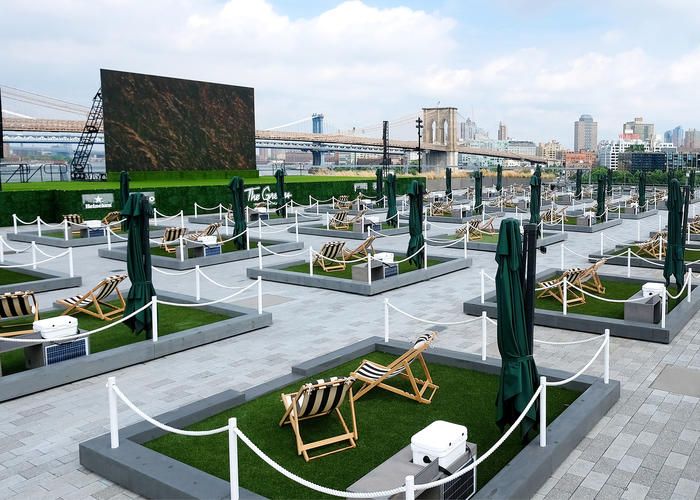
Atop the roof deck of Pier 17 in the summer months, you can rent your own lawn! The Greens at Pier 17 debuted in the summer of 2020 as New Yorkers were seeking more outdoor space while in lockdown. The Greens offers rentable fourteen feet by fourteen feet green spaces that you can reserve for yourself and seven of your friends.
The twenty-eight mini-lawns come equipped with Cabana-style lounge chairs, a sun umbrella, USB charging port, and built-in Yeti cooler, perfect for relaxing. If you are seeking a more active experience, you can also rent a gaming lawn. Gaming lawns are larger, measuring twelve by forty-eight feet, and come with supplies to play cornhole, bocce ball, tic tac toe, ladder ball, or giant jenga. During the winter months, Pier 17 converted open lawns into cozy, enclosed cabins.
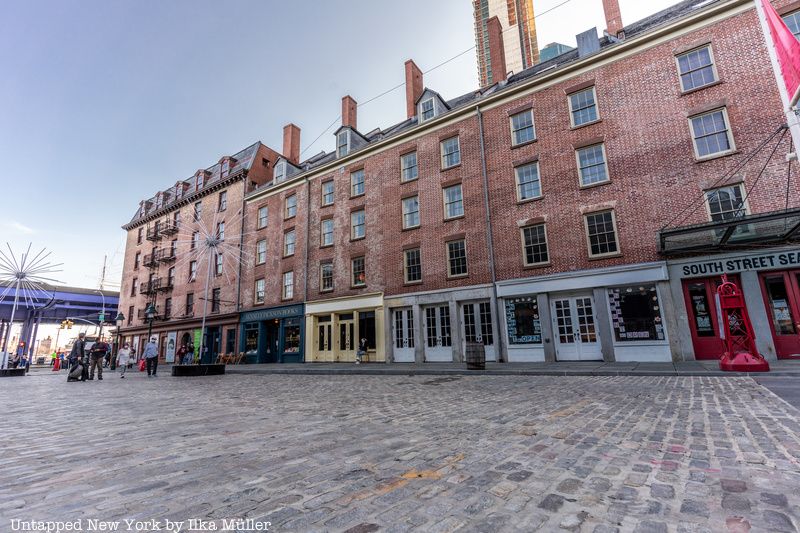
In a study published in 2017 the Historic Districts Council estimated that there are only fifteen miles remain, citywide, of original Belgian block streets. The historic pavers can be found primarily in the historic districts of Tribeca, SoHo, Greenwich Village, Fulton Ferry, DUMBO, Vinegar Hill, and of course, the South Street Seaport.
Most of New York City’s surviving Belgian blocks date to the 18th and 19th centuries. Frequently referred to as cobblestones in casual conversation. Belgian blocks differ from that earlier type of naturally rounded stone. As opposed to cobblestone, Belgian blocks are tooled, usually granite, and much more smooth and resilient.
Next, check out 11 Ships that Have Called NYC’s South Street Seaport Home and 5 5 “Wicked” Secrets of NYC’s 19th Century South Street Seaport
Subscribe to our newsletter